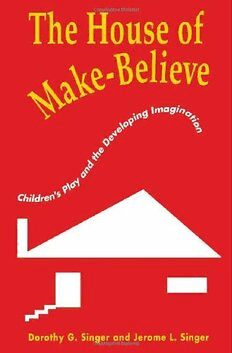
The House of Make-Believe: Children's Play and the Developing Imagination PDF
Preview The House of Make-Believe: Children's Play and the Developing Imagination
The House of Make-Believe The House of Make- Believe Children's Play and the Developing Imagination G. DOROTHY SINGER AND JEROME L. SINGER Harvard University Press Cambridge, Massachusetts London, England Copyright © 1990 by Dorothy G.Singer and Jerome L.Singer All rights reserved Printed in the United States ofAmerica 10 9 8 7 6 5 4 3 2 First Harvard University Press paperback edition, 1992 Library ofCongress Cataloging-in-Publication Data Singer, Dorothy G. The house ofmake-believe: children's play and the developing imagination /Dorothy G.Singer and Jerome L. Singer. p. em. Includes bibliographical references and index. ISBN 0-674-40874-8 (cloth) ISBN 0-674-40875-6 (paper) 1. Play-Psychological aspects. 2. Imagination in children. 3. Developmental psychology. I. Singer, Jerome L. II. Title. BF171.S53 1990 155.4'18-dc20 90-35503 CIP To our children and their children Preface First there's the children's house ofmake-believe. Robert Frost, "Directive" This is a book about the origins, the determinants, and the mani festations ofthe human imagination in childhood and early adoles cence. We approach this intriguing subject primarily as psychologists, that is, as behavioral scientists attentive to available research and systematic theory. But we are also ordinary adults aware ofour own memories ofchildhood play and those ofour chil dren, of their friends, and ofthe many other children we have ob served over the years in nursery schools and daycare centers. As clinicians we have been exposed to the therapeutic play ofdisturbed children and the retrospective reports of adult patients in treat ment. As avid readers with a special interest in the imagination, we have been on the lookout for memories of childhood play in pub lished biographies and personal memoirs, and for childhood scenes in fiction. Our hope is that we can share this wide-ranging view of early imaginative play with a broad group ofreaders. Weaddress this booktobehavioral scientists, mental health work ers, teachers, parents, and those who are simply curious about the special mystery ofhow we develop our human capacity for mental travel through time and space. Yet despite its comprehensive cov erage ofthe available research, this book is not a textbook. Rather, we have tried to combine a scientific and a humanistic approach in a series ofessays that draw on both clinical and literary data while still according the greatest importance to systematic observation and experimental research. The inherently private nature of imagination and fantasy pre sents an almost insurmountable obstacle to its definitive study through the relatively "objective" methods oflaboratory observation and experimentation. Researchers ofchildhood have succeeded, nev ertheless, in developing such observational and experimental pro- viii • Preface cedures sufficiently to permit us to test the hypotheses, suggestions, and even the theories we generate through introspection and clini cal experience. Yet without memories of play, conversations with children, and literary accounts, in which fine writers, drawing on reminiscence and observation, hold up mirrors to our own lives, our presentation of available knowledge might be spare and unengag ing. We have therefore chosen to intersperse our review oftheoret ical issues and formal research findings with personal recollections as well as clinical observations in order to flesh out and vivify our subject matter. We hope we can help readers to recognize the value ofthe scientific approach to data collections, while also encouraging their personal involvement in our subject. Wethus begin with a series ofchildhood memories. In assembling them we have spent some wonderful hours poring through the re markable biographical collection ofEdith Cobb, philanthropist, so cial worker, and friend of researchers Margaret Mead and Erik Erikson. More than 250 volumes are housed in the special collection she willed to the library ofTeachers College, Columbia University, which was being organized by Margaret Mead shortly before her owndeath. From these and other sources wehave selected examples from the childhoods ofthe famous, or nearly famous, and those less well-known people who simply wished to record their life experi ences. Webelieve they suggest many possible ways in which child hood imagination begins and develops. We could have carried out a quantitative analysis, memoir by"memoir,ofspecificinstances, but given the cultural diversity ofthese writers and their differing ob jectives, our effort might have proved only pseudoscientific. Instead, as wehave suggested, we serve them up as a charming first course. But they are more than that. Werecognize that childhood fantasies, like the childhood games weplayed, are not purely idiosyncratic but are indeed a reflection ofour common humanity. A book such as this could not be completed without valuable assis tance from many people and, of course, the participation in our research ofhundreds ofchildren and parents, who must necessarily remain anonymous. The opportunity to make use ofthe great col lection of autobiographies and childhood reminiscences housed in the Edith Cobb collection at the Russell Library, Teachers College, Columbia University, was of special importance for us. We spent happy hours reviewing the fascinating material available there, and we wish especially to thank David M. Ment, Head of Special Col- Preface • ix lections, for his hospitality and guidance. Marianna Kastner and Julie Sincoff aided us considerably in locating relevant research references. Virginia Hurd typed the many drafts ofthe manuscript on her word processor and was helpful in numerous ways. Com ments on particular chapters by Marjorie Janis and Alan Kazdin were useful. Helen Glixon provided the valuable index. Finally, we acknowledge the sustained encouragement and concrete editing as sistance ofAngela von der Lippe and Linda Howe ofHarvard Uni versity Press.
